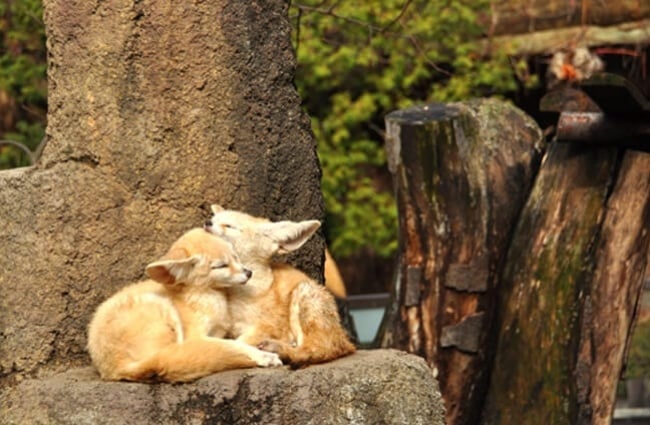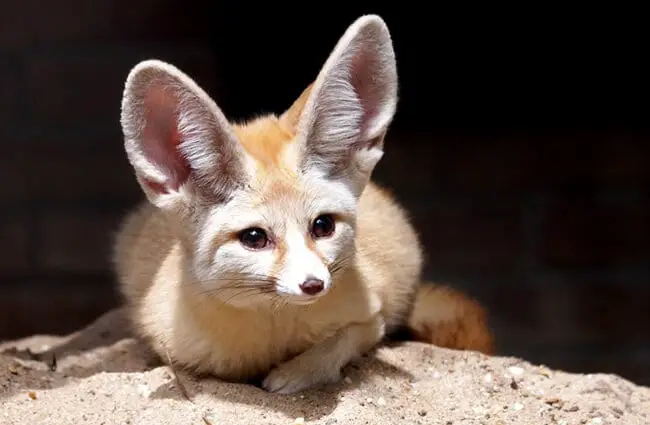The desert holds many secrets, but few are as enchanting and perfectly adapted as the Fennec Fox. With its impossibly large ears and delicate features, this diminutive canid captures the imagination, embodying the spirit of the vast, arid landscapes it calls home. Far more than just a cute face, the Fennec Fox is a master of survival, a living testament to evolution’s ingenuity in the face of extreme conditions.
Join us on a journey into the world of the Fennec Fox, exploring its fascinating biology, its intricate dance with the desert ecosystem, and its surprising interactions with humanity.

An Introduction to the Desert’s Smallest Canid
The Fennec Fox, scientifically known as Vulpes zerda, is the smallest species of fox in the world. Its name is derived from the Arabic word ‘fanak’, meaning fox, and ‘zerda’ from the Greek word for dry, referring to its desert habitat. These creatures are instantly recognizable by their disproportionately large ears, which can grow up to six inches long, and their thick, sandy-colored fur.
Physical Characteristics and Adaptations
Beyond their iconic ears, Fennec Foxes possess a suite of adaptations that allow them to thrive in some of the planet’s harshest environments. Their fur is not just for camouflage against the desert sands; it also provides excellent insulation, protecting them from the scorching daytime sun and the chilling desert nights. The soles of their paws are covered in thick fur, acting like snowshoes to protect them from hot sand and provide traction.
Their size is another key adaptation. Weighing typically between 2.2 and 3.3 pounds and standing only about 8 inches tall at the shoulder, their small stature helps them minimize heat absorption and navigate complex burrow systems with ease.

Life in the Sands: Habitat and Behavior
The Fennec Fox is a true desert dweller, primarily inhabiting the Sahara Desert and other arid regions of North Africa, extending eastward to the Sinai Peninsula and parts of the Arabian Peninsula. Their preferred habitats include sandy deserts and semi arid areas with stable sand dunes and sparse vegetation, which they utilize for cover and food sources.
Nocturnal Nomads
To cope with extreme desert temperatures, Fennec Foxes are primarily nocturnal. They spend the blistering daylight hours deep within complex underground burrows, emerging at dusk to hunt and forage. These burrows are not simple holes; they are intricate networks of tunnels and chambers, often dug in sand dunes or amongst vegetation, providing shelter for entire family groups.
Dietary Delights of the Desert
Fennec Foxes are opportunistic omnivores, meaning their diet is incredibly varied and depends on what is available in their harsh environment. Their keen sense of hearing, aided by those enormous ears, allows them to detect prey moving underground or at a distance. A typical Fennec Fox diet includes:
- Insects: Grasshoppers, locusts, beetles, and crickets are staples.
- Small Vertebrates: Rodents, lizards, geckos, and small birds.
- Eggs: Bird and reptile eggs are a welcome find.
- Plants: Roots, tubers, fruits (especially berries), and leaves provide essential moisture and nutrients.
They are remarkably efficient at extracting moisture from their food, a critical adaptation in an environment where water is scarce. They can survive for extended periods without free water, obtaining most of their hydration from their diet.

The Fennec Fox Family: Reproduction and Social Structure
Fennec Foxes are social animals, typically living in family groups of up to 10 individuals, consisting of a mated pair, their current litter, and sometimes older offspring. They are believed to be monogamous, forming strong pair bonds that last for life.
Mating and Raising Pups
The breeding season usually occurs between January and February. After a gestation period of approximately 50 to 52 days, the female gives birth to a litter of 1 to 4 pups in March or April. The pups are born blind and helpless, weighing only about 1.7 ounces. They are entirely dependent on their mother for the first few weeks.
Both parents participate in raising the young, with the male bringing food to the female while she nurses the pups in the den. Pups open their eyes after about 10 days and begin to explore outside the den at around 4 weeks old. They are weaned at 6 to 7 weeks and reach sexual maturity at around 9 to 11 months of age. Young Fennec Foxes may stay with their family group for up to a year, learning vital survival skills before dispersing to find their own territories.

Fennec Foxes in the Ecosystem and Human World
Ecological Role
As both predator and prey, Fennec Foxes play an important role in their desert ecosystem. They help control populations of insects and small rodents, contributing to the balance of their environment. In turn, they can fall prey to larger desert carnivores such as eagles, jackals, and caracals, though their nocturnal habits and burrowing skills offer significant protection.
Evolutionary History
The Fennec Fox belongs to the Canidae family, which includes dogs, wolves, and other foxes. While its exact evolutionary lineage within the Canidae is debated, it is considered a basal member of the genus Vulpes, suggesting it diverged early from other fox species. Its unique adaptations to extreme desert life highlight a specialized evolutionary path, distinct from its more temperate relatives.
Fennec Foxes and Human Culture
The Fennec Fox holds a special place in some human cultures. It is the national animal of Algeria, symbolizing the country’s unique desert heritage. Its image is often used in art, folklore, and as a mascot, representing agility, cunning, and resilience. While not as widely recognized as some larger carnivores, its distinctive appearance makes it a memorable figure.
Interactions with Humans
Human interaction with Fennec Foxes is multifaceted. Historically, they have been hunted for their fur by some indigenous desert communities, though this practice is less common today. More recently, the Fennec Fox has gained popularity in the exotic pet trade, a trend that raises significant ethical and welfare concerns. While they can be tamed, their complex needs as wild animals are challenging to meet in a domestic setting.
For hikers or travelers encountering a Fennec Fox in the wild, the best course of action is always to observe from a respectful distance. These animals are shy and generally pose no threat. Do not attempt to approach, feed, or capture them. Enjoy the rare privilege of witnessing a wild creature in its natural habitat without disturbing it.
Caring for Fennec Foxes in Captivity: A Zookeeper’s Guide
For zoologists and zookeepers, providing optimal care for Fennec Foxes in captivity requires a deep understanding of their natural history and specialized needs. The goal is to replicate their desert environment as closely as possible.
Essential Tasks for Zookeepers:
- Enclosure Design:
- Provide a spacious enclosure with deep substrate (sand or sandy soil) for extensive burrowing.
- Include multiple den boxes or artificial burrows for security and rest.
- Offer climbing opportunities with rocks and branches.
- Ensure escape-proof fencing, as they are excellent diggers and jumpers.
- Temperature Regulation:
- Maintain a warm ambient temperature, mimicking their desert home.
- Provide heat lamps or heated dens for colder periods.
- Offer shaded areas for cooling.
- Diet:
- A varied diet is crucial, reflecting their omnivorous nature.
- Primary components should include high-quality commercial carnivore diet.
- Supplement with a wide range of insects (crickets, mealworms, superworms).
- Offer small prey items like mice or chicks (if appropriate for the individual fox).
- Include fruits, vegetables, and occasional eggs.
- Ensure constant access to fresh water, despite their low water intake in the wild.
- Social Enrichment:
- Fennec Foxes are social; house them in pairs or small family groups if possible and compatible.
- Provide puzzle feeders, scent enrichment, and novel objects to stimulate natural foraging behaviors.
- Offer opportunities for digging and exploring.
- Veterinary Care:
- Regular health checks, vaccinations, and parasite control are essential.
- Monitor for common issues like dental problems or nutritional deficiencies.
What to Avoid in Captivity:
- Isolation: Unless medically necessary, avoid housing Fennec Foxes alone, as they are social animals.
- Inappropriate Substrate: Do not use substrates that prevent digging or are harmful if ingested.
- Extreme Temperatures: Avoid prolonged exposure to cold temperatures or drafts.
- Monotonous Diet: A diet lacking variety can lead to nutritional deficiencies and boredom.
- Lack of Enrichment: A barren enclosure will lead to stress and abnormal behaviors.
- Handling Stress: Minimize unnecessary handling, as they are naturally shy and can be easily stressed.

Fascinating Fennec Fox Facts
Here is a collection of intriguing facts about these remarkable desert dwellers:
- Super Hearing: Their enormous ears can detect prey moving underground, even tiny insects.
- Thermoregulation: The large surface area of their ears also helps dissipate body heat, acting like natural radiators.
- Desert Runners: Fennec Foxes are incredibly agile and fast, capable of reaching speeds up to 20 miles per hour.
- Deep Diggers: They can dig burrows incredibly quickly, disappearing into the sand within minutes.
- Unique Vocalizations: They communicate using a variety of sounds, including barks, yips, whimpers, squeaks, and growls.
- Water Conservation: Their kidneys are highly adapted to conserve water, producing very concentrated urine.
- Fur on Paws: The furry soles of their feet protect them from hot sand and provide excellent grip.
- Lifespan: In the wild, Fennec Foxes typically live for about 10 years, but in captivity, they can live up to 14 years.
- Smallest Canid: They hold the title for the smallest species in the dog family.
- Excellent Jumpers: Despite their small size, they can jump up to 2 feet high and 4 feet long.
Conclusion: A Desert Gem
The Fennec Fox is a marvel of natural engineering, a creature perfectly sculpted by the forces of evolution to thrive in one of Earth’s most challenging environments. From its iconic ears to its intricate burrowing habits, every aspect of its biology and behavior tells a story of adaptation and resilience. Understanding these captivating animals not only enriches our knowledge of biodiversity but also underscores the importance of preserving the delicate ecosystems they call home. Whether observed in the wild or cared for in a zoological setting, the Fennec Fox continues to inspire awe and curiosity, reminding us of the endless wonders hidden within the natural world.

![Red Angus Closeup of a beautiful Red Angus cowPhoto by: U.S. Department of Agriculture [pubic domain]https://creativecommons.org/licenses/by/2.0/](https://animals.net/wp-content/uploads/2020/03/Red-Angus-4-238x178.jpg)




![Red Angus Closeup of a beautiful Red Angus cowPhoto by: U.S. Department of Agriculture [pubic domain]https://creativecommons.org/licenses/by/2.0/](https://animals.net/wp-content/uploads/2020/03/Red-Angus-4-100x75.jpg)

